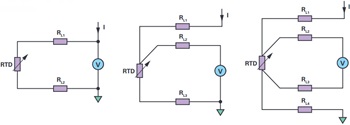Simple Realization of a Fully Integrated 4-Wire RTD Temperature Measurement System for High Precision Measurement Applications
Simple Realization of a Fully Integrated 4-Wire RTD Temperature Measurement System for High Precision Measurement Applications
by
Thomas Brand
Aug 1 2019
For a wide variety of products, manufacturing processes require highly precise and reliable temperature measurement technologies. Temperature is often measured through direct contact with a sensor, for example, through immersion of a sensor in liquid or through contact with the surface of a machine. Aside from thermistors and thermocouples, resistance temperature detectors (RTDs) are especially suitable because of their fast response times and superior sensitivities up to a few hundred µV/°C. They can also be used for measurement over a very wide range of –200°C to +800°C with nearly linear behavior. RTDs are available in a variety of versions, for example, with 2, 3, or 4 wires, offering a high degree of application flexibility.
To generate the measurement voltage, the RTD requires an excitation current. Depending on the RTD type, the voltage level varies from several tens to a few hundreds of millivolts. The accuracy of the measurement system depends not only on the temperature sensors but also on the selection of suitable measuring instruments, the system configuration, as well as the measurement circuit type. Depending on the number of wires, RTD sensors can be used in 2-, 3-, or 4-wire measurement circuits. A comparison of these different measurement circuits is shown in Figure 1.

Figure 1. Comparison of 2-, 3-, and 4-wire measurements.
In the 2-wire measurement circuit, the two wires that supply the RTD with excitation current (I) are also used to measure the sensor voltage. Due to low sensor resistance, even relatively low wire resistances RL produce relatively high measurement inaccuracies. In 3- or 4-wire measurement systems, this error can be minimized because the sensor excitation occurs via separate wires and the sensor’s measurement wires are placed directly on the measuring device inputs, which usually have a high impedance.
Due to the low voltage drop across the RTD, the signals are, unfortunately, very prone to being noisy. Long measurement wires should hence be avoided whenever possible. The noise can be reduced through amplification of the voltage as close as possible to the signal source or the RTD. In addition, sensitive analog-to-digital converters (ADCs) with a good signal-to-noise ratio (SNR) should be used for further data processing. Σ-Δ ADCs such as the AD7124 family from Analog Devices offer a fully integrated, 24-bit, low noise analog front end (AFE), which is ideal for high precision measurement applications. The inputs can be selectively configured as differential or single-ended/pseudo differential inputs. The AD7124 family also has an integrated digital filter and a programmable amplifier stage, making it ideal for low voltage applications. The circuit depicted in Figure 2 shows a 4-wire measurement configuration example using the AD7124.

Figure 2. A 4-wire RTD temperature measurement configuration with the AD7124.
The analog pins AIN2 and AIN3 on the AD7124 are configured as differential inputs and measure the RTD voltage. The excitation current for the RTD is drawn internally from the analog supply voltage AVDD and supplied via AIN0. The excitation current flows simultaneously through the reference resistor RREF1, operating as a precision resistor, causing a voltage drop that is then detected via the reference pins REFIN1(+) and REFIN1(–). The voltage drop created is directly proportional to the voltage drop across the RTD. This ratiometric configuration ensures that changes in the excitation current have no effect on overall system accuracy. RREF2 generates an offset voltage that is required for proper operation due to the ADC’s active internal analog buffers. The buffers are needed to filter the readings prior to analog-to-digital conversion, thereby providing antialiasing and reducing noise. Alternatively, it would also be possible to connect all analog inputs and the reference inputs with discrete RC filters. Calibrating the measurement system (zero-scale and full-scale calibration) to minimize gain and offset errors before starting the measurement is also easy with the AD7124.
Conclusion
With AFEs such as the AD7124 family, RTD temperature measurement systems can be realized relatively easily. They offer a very good combination of high accuracy, low power, and low noise, suitable for high precision measurement applications and for power-saving portable devices. In addition, the level of integration and flexibility of these ADCs simplifies the design architecture and help to shorten the design cycle for measurement applications (for example, temperature, current, voltage, etc.) using different types of sensors.
About the Authors
Thomas Brand began his career at Analog Devices in Munich in October 2015 as part of his master’s thesis. From May 2016 to January 2017, he was part of a trainee program for field application engineers at Analog Devices. A...
Related to this Article
Products
RECOMMENDED FOR NEW DESIGNS
4-Channel, Low Noise, Low Power, 24-Bit, Sigma-Delta ADC with PGA and Reference
RECOMMENDED FOR NEW DESIGNS
8-Channel, Low Noise, Low Power, 24-Bit, Sigma-Delta ADC with PGA and Reference




















